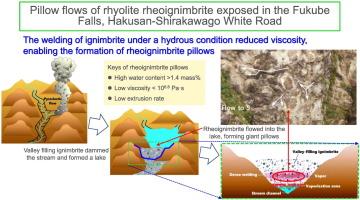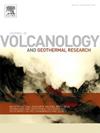白川白川白路,福部瀑布中暴露的流纹岩流光斑枕状水流
IF 2.3
3区 地球科学
Q2 GEOSCIENCES, MULTIDISCIPLINARY
Journal of Volcanology and Geothermal Research
Pub Date : 2025-09-15
DOI:10.1016/j.jvolgeores.2025.108444
引用次数: 0
摘要
位于Jadani河上游的Fukube瀑布暴露了70 Ma Futomiyama群的连续层,这些层基本上是地面上的点烟煤,它与巨大枕头的流质点烟煤层相穿插。枕状层从东到西长320米,厚度从15米到84米不等。枕叶分叉表明西枕、中枕和东枕分别向南、向东和西南流动。枕瓣高度1 ~ 9 m以上,宽度1 ~ 13 m,平均分别为3.4±1.6 m和4.2±2.1 m。高宽比为0.78,与夏威夷Loihi海山近代拉斑岩枕的范围相似,大于白垩纪阿曼蛇绿岩枕的范围。枕缘黑曜石玻璃为流纹岩成分,SiO2质量% 77。根据角闪石地温计,根据含水量的不同,岩浆温度估计在782℃至810℃之间。枕瓣高度的模拟实验约束了流变镁的挤出速率和粘度的上下限。此外,德沃拉数,应变积累率与应变松弛率之比,也给出了最大粘度和挤出率,允许形成连贯的枕头而不会碎裂。基于这些约束条件,枕瓣形成的条件是:黏度在104.5 ~ 106.8 Pa·s之间,点源的挤压速率在2.4 ~ 3.1 × 103 m3/s之间,线源的挤压速率在2.4 ~ 3.1 × 10−3 m2/s之间。这样的黏度要求岩浆的含水量超过1.4质量%,这表明最初在陆地上挤压并在水饱和条件下放置的火成岩是由水焊接而成的。本文章由计算机程序翻译,如有差异,请以英文原文为准。

Pillow flows of rhyolite rheoignimbrite exposed in the Fukube Falls, Hakusan-Shirakawago White Road
The Fukube Falls in the upper Jadani River exposes successive layers of essentially subaerial ignimbrite of the 70 Ma Futomiyama Group, that intervenes a rheoignimbrite layer of giant pillows. The pillowed layer extends 320 m from east to west and varies in thickness from 15 m to 84 m. The bifurcating pillow lobes indicate that the western, central and eastern pillows flowed southward, eastward and southwestward, respectively. The pillow lobes range from 1 to more than 9 m in height and from 1 to 13 m in width, with an average of 3.4 ± 1.6 m and 4.2 ± 2.1 m, respectively. The height/width ratio is 0.78, which is similar to the ranges for tholeiite pillows of the Recent Loihi Seamount, Hawaii, and larger than those of the Cretaceous Oman Ophiolite. The obsidian glass of the pillow margin has a rhyolitic composition with 77 mass% SiO2. The magma temperature is estimated from 782 °C to 810 °C, depending on the water content, based on the hornblende geothermometer. Analogue experiments on pillow lobe height constrain the upper and lower limits of extrusion rate and viscosity of the rheoignimbrite. In addition, the Devorah number, the ratio of rate of strain accumulation to the rate of strain relaxation, also gives the maximum viscosity and extrusion rate that allows for the formation of coherent pillows without fragmentation. Based on these constraints, the conditions of pillow lobe formation are viscosities ranging from 104.5 Pa·s to 106.8 Pa·s, and extrusion rates from 2.4 × 10−3 m3/s to 3.1 × 103 m3/s for point sources and from 2.4 × 10−3 m2/s to 3.1 × 102 m2/s for line sources. Such viscosities require water contents of the magma more than 1.4 mass%, suggesting the hydrous welding of ignimbrite that was initially extruded on land and was emplaced under water-saturated conditions.
求助全文
通过发布文献求助,成功后即可免费获取论文全文。
去求助
来源期刊
CiteScore
5.90
自引率
13.80%
发文量
183
审稿时长
19.7 weeks
期刊介绍:
An international research journal with focus on volcanic and geothermal processes and their impact on the environment and society.
Submission of papers covering the following aspects of volcanology and geothermal research are encouraged:
(1) Geological aspects of volcanic systems: volcano stratigraphy, structure and tectonic influence; eruptive history; evolution of volcanic landforms; eruption style and progress; dispersal patterns of lava and ash; analysis of real-time eruption observations.
(2) Geochemical and petrological aspects of volcanic rocks: magma genesis and evolution; crystallization; volatile compositions, solubility, and degassing; volcanic petrography and textural analysis.
(3) Hydrology, geochemistry and measurement of volcanic and hydrothermal fluids: volcanic gas emissions; fumaroles and springs; crater lakes; hydrothermal mineralization.
(4) Geophysical aspects of volcanic systems: physical properties of volcanic rocks and magmas; heat flow studies; volcano seismology, geodesy and remote sensing.
(5) Computational modeling and experimental simulation of magmatic and hydrothermal processes: eruption dynamics; magma transport and storage; plume dynamics and ash dispersal; lava flow dynamics; hydrothermal fluid flow; thermodynamics of aqueous fluids and melts.
(6) Volcano hazard and risk research: hazard zonation methodology, development of forecasting tools; assessment techniques for vulnerability and impact.

 求助内容:
求助内容: 应助结果提醒方式:
应助结果提醒方式:


